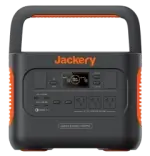Portable power stations have become an essential part of outdoor adventures and emergency preparedness. In this article, we provide an in-depth comparison of the Jackery Explorer 1000 Pro and the Jackery Explorer 1000, based on our hands-on experience with both devices. We will evaluate them on specifications, charging methods, output ports, and overall user experience.
Jackery Explorer 1000 Pro vs Explorer 1000 Side-by-Side:
| Jackery Explorer 1000 Pro | Jackery Explorer 1000 | |
|---|---|---|
 |  |
|
| Battery Capacity | 1002Wh (43.2V 23.2Ah) | 1002Wh (21.6V, 46.4Ah) |
| Battery Lifecycle | 1000 cycles to 80%+ capacity | 500 cycles to 80%+ capacity |
| AC Output: | 120VAC, 60Hz, 1000W (2000W Surge) | 110VAC, 60Hz, 1000W (2000W Surge) |
| Recharge times: | AC Adapter: 1.8 Hours 12V Car Adapter: 12 Hours | AC Adapter: 7 Hours 12V Car Adapter: 14 Hours |
| Weight | 25.4lbs | 22.04 lbs |
| Dimensions LxWxH | 13.39 x 10.32 x 10.06 in | 13.1 x 9.2 x 11.1 in |
| Warranty | 3-years | 2-years |
| Price | Check on Amazon | Find on Jackery.com |
Charging and Recharge Times
After testing both devices, we found that the Jackery Explorer 1000 Pro has a clear advantage in terms of recharge times. With an AC input of up to 800W, it took only 1.8 hours for a full charge, whether we were using solar panels or wall charging. In contrast, the Jackery Explorer 1000 required 7 hours for a full charge with an AC adapter and 8 hours using 2 SolarSaga 100W solar panels.
During our solar charging tests, the Explorer 1000 Pro demonstrated broader compatibility. It worked with all Jackery solar panels, and when connected to 4*200W Solar Panels, it charged fully in 1.8 hours. The Explorer 1000, on the other hand, could be charged with 2 SolarSaga 100W solar panels in 8 hours.
Size and Weight
In our hands-on experience, we noted that the Explorer 1000 Pro is heavier but has a more compact design than the Explorer 1000. It weighs 25.4lbs and has a foldable handle for easy transportation and storage. The Explorer 1000, on the other hand, weighs 22.04lbs, and while it also has a solid handle for carrying, it does not feature a foldable design.
Output Ports and Power
During our tests, both devices had a 1002Wh capacity, providing 1000W of continuous power and 2000W of surge power. The Explorer 1000 Pro outperformed the Explorer 1000 in terms of output ports, offering dual 100W PD ports for fast-charging devices like phones, iPads, drones, and cameras. It supported up to 8 devices simultaneously, with 31000W AC ports, 2 USB-A ports, 2* USB-C ports, and a DC car port.
In comparison, the Explorer 1000 features two USB-C, two USB, one DC car port, and three pure sine wave AC outlets. While the device powered a variety of electronics during our tests, it did not have the dual 100W PD ports that the Pro version offers.
Battery Life and Safety Features
Throughout our testing period, the Explorer 1000 Pro demonstrated an ultra-long standby time, lasting 10 years for 1 usage/week. With a low self-discharge rate, it could last 365 days from an 80% battery level, making it a reliable choice for off-grid living and power outages. The device also comes with a pure sine wave inverter, delivering stable power that prevented equipment damage in our tests. Additionally, the adjustable LED light proved handy for outdoor needs.
On the other hand, the Explorer 1000 had a lifecycle of 500 cycles to 80%+ capacity, which was less impressive compared to the Pro version. Although it also featured a BMS, over-voltage protection, and short-circuit protection during our tests, it lacked the adjustable LED light found in the Pro version.
Warranty and Additional Features
The Explorer 1000 Pro comes with a 3-year warranty, while the Explorer 1000 has a 2-year warranty. During our hands-on experience, the Pro version’s innovative smart screen display with 18 functioning modes provided clear viewing and easy use, allowing us to monitor the charging status, output, and remaining battery life at a glance.
PROS & CONS:
Explorer 1000 Pro

Pros
- Fast 1.8-hour solar/wall charging
- Dual 100W PD fast charge
- Foldable handle for portability
- Innovative smart screen display
- Ultra-long standby time
Cons
- Heavier than Explorer 1000
- Higher price point
Explorer 1000

Pros
- Multiple output ports
- Eco-friendly solar charging
- Portable with solid handle
- Safe and easy to use
- 1000W continuous power output
Cons
- Slower charging times
- No dual 100W PD ports
Jackery Explorer 1000 Pro vs Explorer 1000: Conclusion
Based on our hands-on testing and comparison, we can confidently conclude that the Jackery Explorer 1000 Pro outperforms the Explorer 1000 in several key aspects, including charging times, output port options, battery life, and additional features such as the adjustable LED light and smart screen display. While the Explorer 1000 is a powerful and reliable power station, the Explorer 1000 Pro offers a more comprehensive and versatile user experience, making it an excellent choice for outdoor enthusiasts and those seeking a dependable backup power source for emergencies or off-grid living. >>> Find it on Amazon
